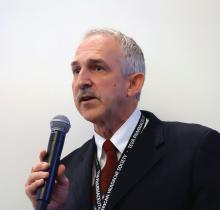SAN FRANCISCO – Many migraineurs claim that changes in the weather can trigger their headache attacks. It took a headache specialist together with a meteorologist poring over surface weather maps to prove they are right.
“When patients tell you they can predict a headache from the weather, they really can,” Vincent T. Martin, MD, declared in presenting the evidence at the annual meeting of the American Headache Society.
Many physicians have been skeptical of patient self-reports of a weather/migraine connection because of mixed results in prior studies examining the impact of a single meteorologic factor at a time, such as barometric pressure, temperature, humidity, or wind speed.
“These studies, however, fail to account for the fact that weather events represent a confluence of meteorologic factors that occur in a specific temporal sequence. It may be necessary to model several variables together to achieve the optimal weather models,” explained Dr. Martin, a general internist, professor of medicine, and director of the Headache and Facial Pain Center at the University of Cincinnati.
He presented a retrospective cohort study of 218 patients with episodic migraine with a mean of 8.9 headache days per month who kept a daily electronic headache diary during two prior studies conducted in the St. Louis area. Their diary data were matched with hourly measurements of barometric pressure, temperature, relative humidity, and wind speed recorded at five St. Louis–area weather stations and archived at the National Climatic Data Center. Dr. Martin and his coinvestigators then created a series of models that predicted the weather conditions that were associated with each individual patient being in the top tertile for the presence of headache on a given day with no headache on the day before.
Preliminary analysis indicated that the most important predictor of new-onset headache in winter, spring, and fall was the barometric pressure differential between 2 consecutive days. These differentials were much smaller in the summer, so a separate model was created for that season. Multiple models were developed to identify binary cutpoints for each weather variable.
From fall through spring, during periods when barometric pressure was in the top tertile – that is, a high-pressure system was in play – a day-to-day difference in mean daily barometric pressure greater than 0.1 mm Hg was associated with a 4.9-fold increased risk of being in the top tertile for new-onset headache, and less than a 25% difference in minimal daily relative humidity was associated with a 4.6-fold increased risk.
In contrast, when barometric pressure was in the lowest tertile, a drop in mean daily barometric pressure of 0.05 mm Hg or less from one day to the next was associated with a 3.17-fold increased risk of entering the top tertile for new-onset headache, and a day-to-day increase in maximal wind speed of 7 mph or more was associated with a 2.64-fold increased risk.
In middle-tertile periods of barometric pressure, a drop in mean pressure of 0.05 mm Hg or less was associated with a 2.21-fold increase in new-onset headache, and a mean daily relative humidity of 79% or greater conferred a 4.43-fold relative risk.
“It’s very rare in epidemiologic studies to get magnitudes of association to those degrees,” Dr. Martin observed. “Our results provide strong evidence that weather is associated with days with a high probability of new-onset headache in persons with migraine.”
The mechanisms underlying this association aren’t known. Possibilities worthy of investigation include stimulation of hyperactivity of the sympathetic nervous system, increases in airborne environmental allergens or pollutants, or direct activation of trigeminal afferent nerve fibers, he said.
Dr. Martin reported having no financial conflicts of interest.


